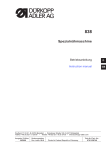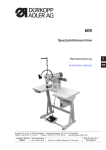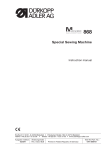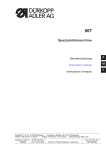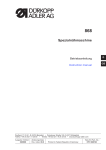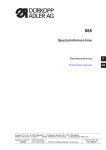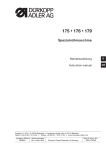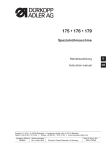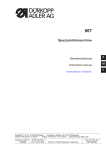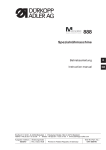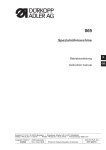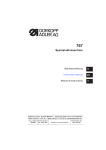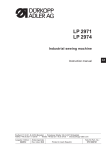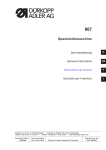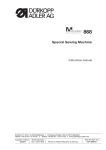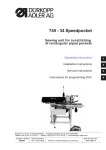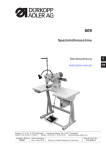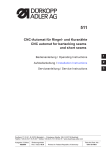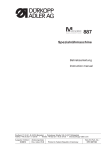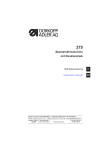Download Duerkopp Adler 669 Instruction manual
Transcript
669 Spezialnähmaschine Betriebsanleitung D Instruction manual GB Postfach 17 03 51, D-33703 Bielefeld • Potsdamer Straße 190, D-33719 Bielefeld Telefon +49 (0) 521 / 9 25-00 • Telefax +49 (0) 521 / 9 25 24 35 • www.duerkopp-adler.com Ausgabe / Edition: 12/2008 Änderungsindex Rev. index: 00.0 Printed in Federal Republic of Germany Teile-Nr./Part.-No.: 0791 669741 Alle Rechte vorbehalten. Eigentum der Dürkopp Adler AG und urheberrechtlich geschützt. Jede, auch auszugsweise Wiederverwendung dieser Inhalte ist ohne vorheriges schriftliches Einverständnis der Dürkopp Adler AG verboten. All rights reserved. Property of Dürkopp Adler AG and copyrighted. Reproduction or publication of the content in any manner, even in extracts, without prior written permission of Dürkopp Adler AG, is prohibited. Copyright © Dürkopp Adler AG - 2008 Foreword This instruction manual is intended to help the user to become familiar with the machine and take advantage of its application possibilities in accordance with the recommendations. The instruction manual contains important information on how to operate the machine securely, properly and economically. Observation of the instructions eliminates danger, reduces costs for repair and down-times, and increases the reliability and life of the machine. The instruction manual is intended to complement existing national accident prevention and environment protection regulations. The instruction manual must always be available at the machine/sewing unit. The instruction manual must be read and applied by any person that is authorized to work on the machine/sewing unit. This means: – – – Operation, including equipping, troubleshooting during the work cycle, removing of fabric waste, Service (maintenance, inspection, repair) and/or Transport. The user also has to assure that only authorized personnel work on the machine. The user is obliged to check the machine at least once per shift for apparent damages and to immediatly report any changes (including the performance in service), which impair the safety. The user company must ensure that the machine is only operated in perfect working order. Never remove or disable any safety devices. If safety devices need to be removed for equipping, repairing or maintaining, the safety devices must be remounted directly after completion of the maintenance and repair work. Unauthorized modification of the machine rules out liability of the manufacturer for damage resulting from this. Observe all safety and danger recommendations on the machine/unit! The yellow-and-black striped surfaces designate permanend danger areas, eg danger of squashing, cutting, shearing or collision. Besides the recommendations in this instruction manual also observe the general safety and accident prevention regulations! General safety instructions The non-observance of the following safety instructions can cause bodily injuries or damages to the machine. 1. The machine must only be commissioned in full knowledge of the instruction book and operated by persons with appropriate training. 2. Before putting into service also read the safety rules and instructions of the motor supplier. 3. The machine must be used only for the purpose intended. Use of the machine without the safety devices is not permitted. Observe all the relevant safety regulations. 4. When gauge parts are exchanged (e.g. needle, presser foot, needle plate, feed dog and bobbin) when threading, when the workplace is left, and during service work, the machine must be disconnected from the mains by switching off the master switch or disconnecting the mains plug. 5. Daily servicing work must be carried out only by appropriately trained persons. 6. Repairs, conversion and special maintenance work must only be carried out by technicians or persons with appropriate training. 7. For service or repair work on pneumatic systems, disconnect the machine from the compressed air supply system (max. 7-10 bar). Before disconnecting, reduce the pressure of the maintenance unit. Exceptions to this are only adjustments and functions checks made by appropriately trained technicians. 8. Work on the electrical equipment must be carried out only by electricians or appropriately trained persons. 9. Work on parts and systems under electric current is not permitted, except as specified in regulations DIN VDE 0105. 10. Conversion or changes to the machine must be authorized by us and made only in adherence to all safety regulations. 11. For repairs, only replacement parts approved by us must be used. 12. Commissioning of the sewing head is prohibited until such time as the entire sewing unit is found to comply with EC directives. 13. The line cord should be equipped with a country-specific mains plug. This work must be carried out by appropriately trained technicians (see paragraph 8). It is absolutely necessary to respect the safety instructions marked by these signs. Danger of bodily injuries ! Please note also the general safety instructions. Contents Page: Preface and General Safety Instructions Part 1: Operating instructions Class 669 (Edition 12/2008) 1. Product Description . . . . . . . . . . . . . . . . . . . . . . . . . . . . . . . . . . . . . . . . . . . . 3 2. Designated Use . . . . . . . . . . . . . . . . . . . . . . . . . . . . . . . . . . . . . . . . . . . . . . . 3 3. Subclasses . . . . . . . . . . . . . . . . . . . . . . . . . . . . . . . . . . . . . . . . . . . . . . . . . . 4 4. Optional Equipment . . . . . . . . . . . . . . . . . . . . . . . . . . . . . . . . . . . . . . . . . . . . 5 5. 5.1 Technical Data Technical data subclasses . . . . . . . . . . . . . . . . . . . . . . . . . . . . . . . . . . . . . . . . . 7 6. 6.1 6.2 6.2.1 Operation Threading the needle thread . . . . . . . . . . . . . . . . . . . . . . . . . . . . . . . . . Adjusting the needle thread tension. . . . . . . . . . . . . . . . . . . . . . . . . . . . . Function of the main thread tension and the supplementary thread tension in relation to the sewing-foot lift for subclass 669-180312 . . . . . . . . . . . . . . . Function of the supplementary thread tension in relation to the stroke adjustment and the Speedomat for subclass 669-180312 . . . . . . . . . . . . . . . . . . . . . . . Adjusting the needle thread tension. . . . . . . . . . . . . . . . . . . . . . . . . . . . . Turning the supplementary thread tension on and off for subclasses 669-180010 and 669-180112. . . . . . . . . . . . . . . . . . . . . . . . . . . . . . . . . . . . . . . . . Adjusting the thread regulator . . . . . . . . . . . . . . . . . . . . . . . . . . . . . . . . Winding the bobbin thread . . . . . . . . . . . . . . . . . . . . . . . . . . . . . . . . . . Replacing the shuttle bobbin . . . . . . . . . . . . . . . . . . . . . . . . . . . . . . . . . Pre-setting the shuttle thread tension. . . . . . . . . . . . . . . . . . . . . . . . . . . . Inserting and replacing the needle . . . . . . . . . . . . . . . . . . . . . . . . . . . . . Raising the sewing feet . . . . . . . . . . . . . . . . . . . . . . . . . . . . . . . . . . . . Setting the sewing feet in the high position . . . . . . . . . . . . . . . . . . . . . . . . Sewing foot pressure . . . . . . . . . . . . . . . . . . . . . . . . . . . . . . . . . . . . . Sewing foot stroke . . . . . . . . . . . . . . . . . . . . . . . . . . . . . . . . . . . . . . . Adjusting the stitch length. . . . . . . . . . . . . . . . . . . . . . . . . . . . . . . . . . . Key pad on the machine arm . . . . . . . . . . . . . . . . . . . . . . . . . . . . . . . . . 6.2.2 6.3 6.4 6.5 6.6 6.7 6.8 6.9 6.10 6.11 6.12 6.13 6.14 6.15 . . . . . . . . . . . . . . 8 9 . . . . . . . 10 . . . . . . . . . . . . . . 11 12 . . . . . . . . . . . . 12 13 14 15 16 17 18 19 19 20 22 23 . . . . . . . . . . . . . . . . . . . . . . . . . . . . . . . . . . . . . . . . . . . . . . . . . . . . . . . . . . . . . . . . . . . . . . . . GB Contents Page: 7. 7.1 7.2 Sewing Sewing with machines using the FIR clutch positioning drive . . . . . . . . . . . . . . . . . . . . Sewing with machines using the Efka DC1550/DA321G positioning drive . . . . . . . . . . . . . 24 25 8. Tilting Back the Machine Head. . . . . . . . . . . . . . . . . . . . . . . . . . . . . . . . . . . . . . 28 9. Folding Down the MG 56-2 Stand . . . . . . . . . . . . . . . . . . . . . . . . . . . . . . . . . . . . 29 10. 10.1 10.2 Maintenance Cleaning and checking . . . . . . . . . . . . . . . . . . . . . . . . . . . . . . . . . . . . . . . . . . . Oil lubrication . . . . . . . . . . . . . . . . . . . . . . . . . . . . . . . . . . . . . . . . . . . . . . . . . 30 32 1. Product Description The DÜRKOPP ADLER 669 is a single-needle double lockstitch free-arm sewing machine featuring a lower feed, a needle feed and an alternating foot-upper feed. Depending on the subclass, it can also come with a thread trimmer, second stitch length and automatic bartacking. The maximum stitch length is either 6 mm or 9 mm, depending on the sewing equipment. The needle thickness is between 100 – 150 Nm. · · · · · · · · · 2. It is equipped with a large horizontal looper hook. The hook cover has a diameter of 48 mm. There is a maximum clearance of 20 mm under the sewing feet when the feet are raised. The remaining thread has a length of about 10 mm, depending on the thread cutting process. The lower feed can be easily deactivated or converted for other purposes such as edge work. A safety clutch prevents the hook from being displaced or damaged if the thread gets jammed in the shuttle track. The machine features automatic wick lubrication and a viewing window in the arm for watching the machine and hook lubrication. GB All subclasses, excluding those classes without a thread trimmer, are equipped with a six-way button An additional pull-down button, within reach of the operator, can optionally be assigned one of the six different functions. There is also an integrated bobbin winder. Designated Use The class 669 machine is a sewing machine head designed for sewing light to medium-heavy material. Such material is generally made of textile fibres, but it may also be leather. It is used in the clothing industry and for domestic and motor-vehicle upholstery. This sewing machine can also be used to produce technical seams. In such a case, the operator must assess the possible dangers which may arise (preferably in conjunction with DÜRKOPP ADLER AG). Such applications are relatively unusual and varied so that no single set of criteria can cover them all. The outcome of this assessment may require appropriate safety measures to be taken. Generally, only dry material may be sewn with this sewing machine head. The material may be no thicker than 10 mm when compressed by the lowered sewing feet. The material should not contain any hard objects. If hard objects are present, the machine must be operated with protective eye wear. We currently do not have such protective eye wear available for delivery. The seam is produced with textile-fibre sewing thread, with size gauges up to 15/3 NeB (cotton), 15/3 Nm (synthetic) or 15/4 Nm (covered yarn). Before using any other thread, you must assess the dangers associated with their use and take appropriate safety measures when necessary. 3 This sewing machine may be set up and operated only in dry, well-maintained premises. If the sewing machine is used in other premises which are not dry and well-maintained it may be necessary to take further precautions which should be agreed in advance (see EN 60204-31: 1999). As manufacturers of industrial sewing machines, we proceed on the assumption that personnel who work on our products will have received training at least sufficient to acquaint them with all normal operations and with any hazards which these may involve. 3. 4 Subclasses 669-180010 Single-needle double lockstitch free-arm sewing machine with lower feed, needle feed and alternating foot-upper feed. 669-180112 Single-needle double lockstitch free-arm sewing machine with lower feed, needle feed and alternating foot-upper feed. Also featuring electro-pneumatic thread trimmer, electro-pneumatic seam bartacking, and sewing-foot lift. 669-180312 Single-needle double lockstitch free-arm sewing machine with lower feed, needle feed and alternating foot-upper feed. Also featuring electro-pneumatic thread trimmer, electro-pneumatic seam bartacking, and sewing-foot lift. Also includes a second stitch length (electro-pneumatic switchable), two lifting heights (electro-pneumatic switchable with knee lever) and an integrated sewing light. 4. Optional Equipment Order no. Optional equipment 669-180010 669-180112 669-180312 The following additional equipment is available for the 669. 9780 000108 WE-8 maintenance unit for additional pneumatic equipment Pneumatic connection package. For connection of stand with maintenance unit. Operating panel angle bracket Halogen sewing light for the sewing machine head Mounting kit for the sewing light Sewing light transformer Diode sewing light (one diode) Integrated sewing light Power supply for the integrated and diode sewing light PCB for oil monitoring Electro-pneumatic needle cooler, from above Mechanical sewing-foot lift, with pedal Pneumatic sewing-foot lift Manual seam tacking Edge guide, swivelling USB memory key (flash drive) for data transfer with Efka DA321G control unit Distance spacer, for mounting additional equipment X X X X X X X X X X X X X o X X X X X X o X X X X o o X X X X o X X o X X X X o X X X X X Stand set MG 53-3. Table plate: 1200 x 550 mm without cut-out Stand set MG 55-3. Table plate: 1200 x 550 mm with cut-out Stand set MG 56-2. Table plate: 1250 x 600, divided, foldable, for clutch motors Stand set MG 56-2. Table plate: 1250 x 600, divided, foldable, for DC1550 X X X X X X X X 0797 003031 0867 9822 9880 0798 9880 9880 9850 490010 510001 867100 500088 867103 867102 001089 9850 867001 0867 590014 0367 595124 0867 590354 0867 590464 N800 080004 9805 791113 0659 510030 Subclasses GB Stand MG55 400384 MG55 400394 MG56 400064 MG56 400074 X X o = Standard equipment X = Optional equipment 5 Further available documents concerning the class 669: 0791 669801 Parts List 0791 669641 Service Instructions 5. Technical Data Noise level: Workplace-related emission value according to DIN 45635-48-A-1-KL-2: 669-180010 LC = —dB (A) Stitch length: _ mm Sewing material: Sewing foot stroke: ___ mm Number of stitches: ____ min -1 669-180112 LC = —dB (A) Stitch length: _ mm Sewing material: Sewing foot stroke: ___ mm Number of stitches: ____ min -1 669-180312 LC = —dB (A) Stitch length: _ mm Sewing material: Sewing foot stroke: ___ mm Number of stitches: ____ min -1 6 5.1 Technical data subclasses Type of stitch Lockstitch 301 Hook type horizontal, large Number of needles 1 Needle system 134-35 Needle thickness, max. (according to E no.) [Nm] Max. sewing thread thickness: Needle thread Bobbin thread [Nm] [Nm] Stitch length Forwards Reverse Max. stitch count Stitch count whendelivered 669-180312 669-180112 669-180010 Subclasses 150 80/3 - 15/3 80/3 - 20/3 GB [mm] 9 9 [min -1 ] [min -1 ] 3000 3000 3000 2800 3000 3000 Max. sewing-foot lift [mm] 9 Max. height of lifted sewing feet [mm] 20 Operating pressure [bar] 6 Air consumption per work cycle [NL] 0.7 Dimensions (L x W x H) (with attached Efka DC 1550) [mm] 600/ 230/ 470 (600/ 300/ 470) Weight (with attached Efka DC 1550) [kg] [kg] 50 (54) 7 6. Operation 6.1 Threading the needle thread 11 1 10 2 3 9 4 8 5 7 6 Caution: danger of injury ! Turn the main switch off ! The needle should be threaded only when the machine is turned off. Threading the needle thread – Put the reel on the reel stand. Guide the needle thread through the unwind holder. The unwind holder must be perpendicular to the reel. – Insert the thread through guide 1 and guide 2. – Pass the thread clockwise around the pre-tensioner 3. – Pass the thread counter-clockwise around the supplementary tensioner 4. – Pass the thread clockwise around main tensioner 5. – Pull the thread under the thread take-up lever 8. Thread through the thread regulator 10 to the thread lever 11. – Pass the thread through thread lever 11 and through guides 9, 7 and 6 on the needle bar. – Pass the thread through the eye of the needle. 8 6.2 Adjusting the needle thread tension 3 2 1 5 4 Pre-tensioner When the main thread tensioner 2 and the supplementary tensioner 3 are open, there must still be a slight tension remaining on the needle thread. This residual tension is created by the pre-tensioner 1. The pre-tensioner 1 influences both the length of the cut needle thread and the starter thread for the next seam. – Basic adjustment: Turn dial 4 until its front side is flush with the bolts 5. – For a shorter starter thread: Turn the dial 4 clockwise. – For a longer starter thread: Turn the dial 4 counter-clockwise. Main tensioner The main tensioner 2 should be adjusted as little as possible. The threads’ cross-over point should be in the centre of the material. If the thread tension is too strong, crimping and thread tearing canoccur when working with a thin material. – Adjust the main tensioner 2 so that you attain a consistent stitch pattern. To increase the tension,turn the dial clockwise. To decrease the tension, turn the dial counter-clockwise. Supplementary tensioner The switchable supplementary tensioner 3 is used for quick changes to the thread tension (for example, when working with thicker seams). – The supplementary tension 3 should be set lower than the main tension 2. 9 GB 6.2.1 Fig. A: Correct thread interlacing in the center of the material Fig. B: Needle-thread tension too weak or Hook-thread tension too strong Fig. C: Needle-thread tension too strong or Hook-thread tension too weak The influence of the sewing-foot lift on the main thread tensioner and supplementary thread tensioner, for subclass 669-180312 Button 1 (see Chapter 6.15) on the machine’s row of buttons can be used to activate or deactivate the supplementary thread tension at any time. The parameter F-299 must be set to "1" for this to work. Sewing-foot lift in the seam Parameter setting F-196=0 F-196=1 F-196=2 F-196=3 Sewing-foot lift after the thread has been cut Main thread Supplementary Main thread Supplementary tension thread tension thread tension tension 0 1 0 1 0 1 0 1 0 0 1 1 0 0 1 1 1 = Thread tension opened mechanically 0 = Thread tension closed mechanically · · 10 If the supplementary thread tensioner is open, the state of the sewing-foot lift does not change. If the machine is turned off, the supplementary thread tension remains at its previously set state. 6.2.2 The influence of the stroke adjustment on the supplementary thread tensioner and the Speedomat, for subclass 669-180312 Button 1 (see Chapter 6.14) on the machine’s row of buttons can be used to activate or deactivate the supplementary thread tension at any time. The parameter F-255 must be set to “7" for this to work. Parameter setting. F-197 F-197 F-197 F-197 = = = = 0 1 2 3 Max. stroke adjustment Stroke adjustment via knee button via dial when the HP speed from parameter F-117 is reached (Speedomat) 1 0 1 (*) 0 1 1 0 0 (*) If the stroke adjustment (max.) is activated via the knee switch and the HP speed (from parameter F-117) has been reached by the “Speedomat”, then the supplementary thread tensioner is automatically activated. 0 = Supplementary thread tension closed mechanically 1 = Supplementary thread tension opened mechanically GB · · If the supplementary thread tensioner is closed, the state of the stroke adjustment does not change. If the machine is turned off, the supplementary thread tension remains at its previously set state. Initial control-box settings for the automatic stepped reduction of the stitch count (Speedomat), using the dial for the height of the alternating feed stroke: Parameter 188 Step 01-21 Step 01-10 Step 11-18 Step 19-21 Entire Speedomat range Maximum allowed stitch count, parameter F-111 = 3000 min 1 Linear step-wise reduction of the maximum stitch count (Speedomat) Maximum allowed stitch count, parameter F-117 = 1.800 min 1 11 6.3 Opening the needle thread tension Subclasses 669-180010 When raising the sewing feet by means of the knee lever, the main and supplementary tensioners are automatically opened. Subclasses 669-180112, 669-180312 The needle-thread tensioner is automatically opened when the thread is cut. 6.4 Turning the supplementary thread tension on and off for subclasses 669-180010 and 669-180112 2 1 The supplementary thread tension is turned on and off using the lever 1. Turning on – Push the knob 2 on the lever 1 to the left. Turning off – Push the knob 2 on the lever 1 to the right. 12 6.5 Adjusting the thread regulator 3 2 1 GB Caution: danger of injury ! Turn the main switch off. Set the thread regulator only with the sewing machine turned off. The thread regulator 1 is used to control the quantity of the needle thread required by the stitch formation. The best sewing results can only be ensured when using a precisely adjusted thread regulator. At the properly adjusted setting, the needle thread loop must be able to slide over the thickest section of the hook. – – – Loosen screw 2. Change the position of the thread regulator 1. Thread regulator to the left = more thread. Thread regulator to the right = less thread. Tighten screw 2. Settings note: At the point where the most thread is required, the thread take-up lever 3 must be pulled up about 0.5 mm from its lower end position. This occurs when the needle thread loop passes the section of the hook with the widest diameter. 13 6.6 5 Winding the bobbin thread 4 3 2 – – – – – – – – 1 2 6 Put the reel on the reel stand. Guide the bobbin thread through the unwind holder. Pull the thread through guide 5, the tensioner 4, and the guide 3. Clamp the thread behind the blade 6 and tear off. Put the bobbin 1 on the bobbin winder. The thread does not need to be hand wound around the bobbin. Press the bobbin-winder lever 2 in the bobbin. Sewing The bobbin-winder lever ends the operation as soon as the bobbin is full. The bobbin winder remains in position so that the blade 6 is properly positioned (refer to the illustration on the right). Take off the full bobbin 1. Clamp the thread behind the blade 6 and tear off. Put an empty bobbin on the bobbin winder for the next winding process and press the bobbin lever 2 into the bobbin. Caution: danger of breakage! If the thread is not being wound during the sewing operation, the sewing foot must be set to the raised position and the sewing-foot stroke must be set to the smallest value. 14 6.7 Replacing the shuttle bobbin 1 3 2 Caution: danger of injury ! Turn the main switch off. Change the shuttle bobbin only when the sewing machine is switched off. 5 4 7 2 6 3 Taking off the empty bobbin – Raise the needle bar into its high position. – Pull out the hook cover 1 and fold down. – Lift up the bobbin enclosure hood 2. – Take out the upper part of the bobbin enclosure 3 with the bobbin 4. – Remove the empty bobbin from the upper part of the bobbin enclosure 3. Inserting a full bobbin – Put a full bobbin in the upper part of the bobbin enclosure 3. Please note the rotational direction of the bobbin. The rotation is correct when the bobbin turns in the opposite direction of the pulling direction of the thread. – Pull the hook thread through the slot 7 under the tension spring 6 and then through the hole 5. – Pull out the tension spring from the bobbin enclosure about 5 cm. When the thread is being pulled out, the bobbin must rotate in the direction shown by the arrow. – Replace bobbin housing 3. – Close bobbin enclosure hood 2. – Close the hook cover 1. Danger of breakage ! Press down firmly on the bobbin housing and make sure that it is correctly locked in. 15 GB 6.8 Pre-setting the hook thread tension 2 1 4 3 Caution: danger of injury ! Turn the main switch off. Only adjust the hook thread tension when the machine is turned off. Brake spring The brake spring 1 is responsible for preventing a bobbin overrun during a machine stop and when the hook thread is being cut. It cannot be adjusted! Setting the tension spring – Adjust the tension spring 4 with the adjustment screw 3. Turn until the required tension force is present. Raising the hook thread tension – Turn the screw 3 clockwise. Decreasing the hook thread tension – Turn the screw 3 counter-clockwise. 16 6.9 Inserting and replacing the needle 1 2 3 2 1 Caution: danger of injury ! Turn the main switch off. Change the needle only when the sewing machine is switched off. – – – – – GB Turn the handwheel until the needle bar 1 has reached its highest position. Loosen screw 2. Pull the needle out from under the needle bar 1. Push in the new needle until it reaches the limit stop in the hole for the needle bar 1. Caution! The needle scarf 3 must be pointing towards the hook. Tighten screw 2. CAUTION ! When changing to a needle with a different thickness (gauge), you must adjust the clearance gap between the hook and the needle (refer to the service instructions). The following errors can result if you do not do this: When using a thinner needle: – Missing stitches and thread damage When using a thicker needle: – Damage to the hook tip and damage to the needle 17 6.10 Raising the sewing feet 1 2 Subclass 669-180010 The sewing feet can be lifted mechanically by pressing the knee lever 1. Subclasses 669-180112, 669-180312 The sewing feet can be lifted electro-pneumatically by pressing the pedal 2 or the knee lever 1. Raising the sewing feet mechanically (with the knee lever) – Push the knee lever 1 to the right in order to move the sewing material (for example, when making corrections). The sewing feet remain in the raised position as long as the knee lever 1 is pressed. Raising the sewing feet electro-pneumatically (with the pedal) – Press the pedal 2 half way back. The sewing feet are raised when the machine is stopped. – Press the pedal 2 all the way back. The thread trimmer will then be activated and the sewing feet will be raised. 18 6.11 Setting the sewing feet in the high position 1 1 – – 2 Swivel lever 1 downwards. Set the sewing feet in the high position. Swivel lever 1 upwards. The sewing feet are released. GB or – The sewing feet are raised pneumatically or with the knee lever. The lever 1 swivels back to its starting position. 6.12 Sewing-foot pressure The knob 2 is used to set the required sewing-foot pressure. CAUTION ! The sewing material should not “swim”. Do not set more pressure than necessary. – – Raising the sewing-foot pressure = Turn the dial 2 clockwise. Lowering the sewing-foot pressure = Turn the dial 2 counter-clockwise. 19 6.13 Sewing-foot stroke 2 1 3 The class 669 sewing machine comes (depending on the subclass) standard equipped with two dials for adjusting the sewing-foot stroke. Use the dial 2 on the left to select the standard sewing-foot stroke from 1 to 9. Use the dial 1 on the right to set a higher sewing-foot stroke from 1 to 9. – Turn dial 1 and 2 (1 to 9): 1 = minimal sewing-foot stroke 9 = maximum sewing-foot stroke Automatic stitch rate limit Machines without a thread trimmer The speed is not verified on these machines. Please observe the notices and the information found in the tables on the next page. Machines with a thread trimmer The sewing-foot stroke and stitch count are interdependent. A potentiometer is connected mechanically with the dial. The control unit detects what foot-stroke has been set by means of this potentiometer and restricts the speed of rotation accordingly. Machines with electro-pneumatic rapid stroke adjustment When processing thick sections of material or when sewing over transversal seams, the higher sewing-foot stroke (dial 1) can be activated while sewing by means of the knee switch 3 (under the table plate). A potentiometer is used here just as in the machines with thread trimmers. CAUTION: Danger of breakage ! The standard sewing-foot stroke as set by the dial 2 must not be larger than the stroke set by the dial 1. 20 Operating mode for the rapid stroke adjustment The activation time for the maximum sewing-foot stroke depends on which operating mode is set. You can select between three different operating modes. The particular modes are specified on the operating panel by setting the parameters F-138 and F-184 (refer to the instructions from the motor manufacturer). Operating mode Operation / Explanation Momentary contact F-138 = 0 F-184 = 0 The maximum sewing-foot stroke remains activated as long as the knee switch 3 is being pressed. Maintained contact F-138 = 1 The maximum sewing-foot stroke is activated when the knee switch 3 is pressed. Pressing the knee switch again will then deactivate the maximum sewing-foot stroke. Momentary contact with minimum stitch count F-138 = 0 F-184 = 0 < 100 The maximum sewing-foot stroke remains activated as long as the knee switch 3 is being pressed. After releasing the knee switch, the machine continues to sew with the maximum sewing-foot stroke until the specified minimum stitch count (parameter F-184) is reached. Afterwards, sewing continues with the standard sewing-foot stroke. 3 Note! The switch 4 on the rear of the knee switch 3 can also be used to switch between the “maintained contact” and “momentary contact” modes. 4 Subclass 669-180010 669-180112 669-180312 1-4 GB NOTE! Do not exceed the max. stitch count limits specified in the table. Observing these limits will ensure safe operations and a long lifespan for the machine. Stitch length range Dial position Sewing-foot stroke [mm] Max. stitch count [min -1 ] 0-6 1-3 4 5 6-9 3000 2500 2100 1800 6-9 5 6-9 2100 1800 2500 21 6.14 Adjusting the stitch length 4 3 2 1 The class 669 sewing machine is equipped with two dials, depending on the subclass. This allows two different stitches to be used when sewing. They can be selected using button 4 (see Chapter 6.15). The stitch lengths are set using the two dials 1 and 2 found on the machine arm. – Set the longer stitch length with the upper dial 1. Position 1 = min. stitch length Position 9 = max. stitch length – Set the shorter stitch length with the lower dial 2. Position 1 = min. stitch length Position 9 = max. stitch length Stitch lengths are equal for both forward and reverse sewing. – Push the stitch regulator lever 3 down in order to manually sew bartacks. The machine will sew backwards as long as the stitch regulator lever 3 is pressed down. Note In order to facilitate the process of adjusting the stitch lengths, the button 2 (see Chapter 6.15) should be used to fix the stitch lengths so that they do not shift. CAUTION: Danger of breakage ! Make sure that the stitch length set with the lower dial 2 is not larger than the stitch length set by the upper dial 1. 22 6.15 Key pad on the machine arm 8 7 6 Key 5 4 3 2 1 Function GB 1 Supplementary tread tension Button is back-lit: the supplementary thread tension is activated. Button is not back-lit: the supplementary thread tension is not activated. 2 2. Stitch length Button is back-lit: long stitch length (upper dial) is activated Button is not back-lit: small stitch length (lower dial) is activated 3 Invoke or suppress the start/final bartacks. If the start and final bartacks are activated, then the next bartack is deactivated when the button is pressed. If the start and final bartacks are not activated, then the next bartack is activated when the button is pressed. 4 Move the needle to the upper or lower position. The function of the button can be set with the parameter F-242. 1 = needle up/down 2 = needle up 3 = single stitch 4 = full stitch 5 = needle to position 2 The factory default setting is 1 (needle up/down). 5 Sew backwards manually. The machine sews backwards for as long as the button is held down. 23 Key Function 8 LED display “Power On” The key 7 can be assigned a function using the screw 6 found under the switch. – Select a function. For example: 6 = sew backwards manually – Then press in the screw under key 5 and turn 90° to the right (the slot is then vertical). This function can now be activated using either key 5 or 7. CAUTION ! You must deactivate any previous assignment before assigning key 9 another function. 7. Sewing 7.1 Sewing with machines using the FIR clutch positioning drive You can find a comprehensive description of the control unit in the current operating instructions from the motor manufacturer (included). 0 1 2 3 With the pedal 0 At rest 1 Sewing forwards with minimum speed 2 Sewing forwards with higher speed ::: 3 Sewing forwards with maximum speed 24 7.2 Sewing with machines using the Efka DC1550/DA321G positioning drive The DA321G control unit contains all required operational interfaces for switching functions and setting parameters. It is possible to operate without an operating panel, but the seam programming can no longer be carried out. The V810 and V820 operating panels can also be connected to the control unit. They are deliverable as accessories. Seam programming can be performed with the V820 operating panel. The “EFKA DC1550 – DA321G” Operating Manual contains a more detailed description of the control unit (also refer to www.efka.net). GB With the pedal The pedal position is detected using a sampling detector with 16 different levels. Their meanings are listed in the table below: Pedal position Pedal movement Meaning -2 Completely backwards Command for cutting the thread (end of seam) -1 Half backwards Command for raising the sewing foot 0 Neutral rest position Refer to comment below 1 Slightly forwards Command for lowering the sewing foot 2 More forwards Sew with miminal speed (first level) 3 More forwards Sew with more speed (second level) Entirely forwards Sew with maximal speed (twelfth level) ::: 13 Comment: The following functions can be programmed to correspond with the rest position: – Needle position (down/up) and sewing-foot position (down/up) when stop in seam. – Sewing-foot position (up/down) after end of seam. (Pedal fully backwards, then in rest position) 25 3 Sewing process Before start of sewing Starting position 2 1 Operation / Explanation - Pedal is in the resting position. The sewing machine is at rest. The needle is up. The sewing feet are down. Position material at seam start - Move pedal back halfway. Raise the sewing feet. - Push the material to the needle. Sewing - Step the pedal forward and hold. The machine then continues to sew with the speed determined by the pedal. In the middle of seam - Release pedal (return to rest position). The machine stops in the first position (needle down). The sewing feet are down. Interrupt sewing operation Continue sewing operation (after releasing the pedal) - Step forward on the pedal. The machine then continues to sew with the speed determined by the pedal. Sewing an intermediate lockstitch - Press the stitch regulator lever 4 downwards. The machine sews in reverse as long as the stitch regulator lever is pressed. The speed is determined by the pedal. or - Press the button 3. 26 4 Sewing over transverse seams (maximum sewing-foot stroke) The maximum sewing-foot stroke is activated. The speed is limited to 1600 min-1. Operating modes for maximum sewing-foot stroke: - Briefly press the knee switch for activating the maximum sewing-foot stroke. - Briefly press the knee switch again for deactivating the maximum sewing-foot stroke. 2 nd set stitch length during sewing (max. stitch length) - Press the button 2. Raise the thread tension during sewing - Press the button 1. At seam end - Step the pedal completely backwards and hold. The final bartack is sewn (when activated). The thread is cut. The machine stops in the second position. The needles are up (reverse rotation). The sewing feet are down. - Take out the material. Remove sewing material GB 27 8. Tilting Back the Machine Head 1 3 2 Caution – Risk of injury from crushing ! Do not reach between the base and the machine arm while you are tilting back the machine head. Tilting back the machine head – Press lever 1 upwards. The locking mechanism is then released. – Tilt the machine head 3 to the rear. The machine head 3 will be supported by the strap 2. Re-closing the machine head – Tilt the machine head 3 forwards. The head tilts back to the position shown in the illustration below. – Pull lever 1 back up and carefully tilt the head downwards. 1 Caution! Only tilt the head up briefly (i.e., for maintenance work). If the head is tilted back for a longer period (for a night or weekend), oil can leak out in the hook area. 28 9. Folding down the MG 56-2 stand 2 1 1 Caution: danger of injury ! Always hold the table plate with both hands when pulling out. GB 4 – – – – Loosen the table plate latch 1 located under the table plate. Pull out the table plate 2 to the left and fold out. Hook in the diagonal brace 4 to the bolts 3. Fold down the table plate. – Follow these steps in the opposite order to raise the table plate. 3 29 10. Maintenance 10.1 Cleaning and checking Caution: danger of injury ! Turn the main switch off. Maintenance work on the sewing machine must only be carried out when the machine is switched off. All maintenance work must be carried out before or at the maintenance intervals defined in the table (refer to the “operational hours” column). When working with materials that are thick and fibrous, shorter maintenance intervals may be required. A clean sewing machine helps to prevent malfunctions. 3 2 1 Maintenance required Explanation Machine head Points to be particularly cleaned: - The area under the throat plate 2 - The area around the hook 1 - The bobbin enclosure - The thread trimmer - The area around the needle 8 Clean dust and residual thread from the air-entry points. 8 - Remove sewing dust and residual thread (you can use compressed air) Direct drive Clean the motor ventilation sieve (you can use compressed air) 30 Operational interval, hours 3 1 4 2 5 Maintenance required Explanation Operational Sewing drive Clean dust and residual thread from the air-entry points 8 You should be able to press down with your finger on the V-belt so that the belt moves about 10 mm down 160 The water level must not rise as far as filter insert 3. - After screwing in drain screw 5 blow out the water from the water separator 4 under pressure. 40 The filter insert 3 is used to filter out dirt and condensation. - Separate the machine from the compressed air supply. - Unscrew blow-out screw 5. There must be no pressure on the machine’s pneumatic system. - Unscrew the water separator 4. - Unscrew the filter insert 3. Wash out the dirty filter bowl and filter insert with benzene (do not use a cleaning solvent). Then blow dry. - Re-assemble the maintenance unit 500 Clean the motor ventilation sieve 2 (you can use compressed air) Check condition and tension on the V-belt 1 Pneumatic System Check the water level in the pressure regulator. Clean the filter insert. Check the system for leaks. interval, hours GB 500 31 10.2 Oil lubrication 1 Caution: danger of injury ! Oil can cause skin rashes. Avoid prolonged skin contact. If oil or grease contacts your skin, wash yourself thoroughly. CAUTION ! The handling and disposal of mineral oils is subject to legal constraints. Deliver used oil to an authorized reception point. Protect your environment. Take care not to spill any oil. Oil the sewing machine exclusively with the lubricating oil DA-10 or an equivalent oil with the following specification: Viscosity at 40° C : 10 mm²/s Flash point: 150° C DA-10 can be purchased at sales branches of DÜRKOPP ADLER AG, under the following part numbers: 250-ml container: 9047 000011 1 litre container: 9047 000012 2 litre container: 9047 000013 5 litre container: 9047 000014 Maintenance required Explanation Lubrication of the machine head The head is equipped with centralized oil wick lubrication. The bearings are supplied by the oil reservoir 1. - The oil level must not drop below the mark 3 on the oil reservoir. The oil reservoir illuminates when the oil level falls below the mark 3. (Only for subclass 669-180312) - Refill oil through the hole 2 until it reaches the “Max” mark. 32 Operational interval, hours 8




































